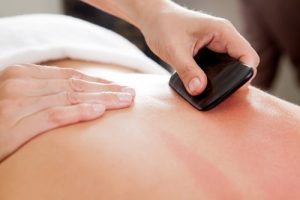 Scraping or guasha uses an edged tool to stroke the skin until redness emerges. It is traditionally used to relieve pain, reduce inflammation, and help recovery from colds and flu’s.
Scraping or guasha uses an edged tool to stroke the skin until redness emerges. It is traditionally used to relieve pain, reduce inflammation, and help recovery from colds and flu’s.
It doesn’t hurt, and the redness disappears within a few hours to a day or so later. The effects are similar to those of cupping but it works at a more superficial level and is better for bony areas with less flesh covering them.
The Chinese word gua sha 刮痧 means something like scraping out hot disease, and in the Chinese understanding it releases pathogenic influences such as heat from superficial layers of the body. For this reason it is often used to treat heatstroke. Cupping is also thought to remove pathogenic influences but it affects deeper layers of tissue. In one sense inflammation may be thought of hot disease and scrapping has been shown to have anti-inflammatory effects.
Just like cupping, scraping relieves pain. Musculo-skeletal pain is often attributed to something the Chinese call “blood stagnation”, and both cupping and guasha “remove” blood stagnation. Another way of thinking of it is that after an injury, and with the formation of scar tissue and tight, less mobile groups of filaments in muscle tissue, there is poor micro-circulation in the region, and both cupping and scraping relax tension in the tissues, encourage remodelling of scar tissue, and improve local micro-circulation.
I wrote a bit more scraping in a blog post here, with a few references to back up what I’m saying.